
The Amazon basin is the part of South America drained by the Amazon River and its tributaries. The Amazon drainage basin covers an area of about 6,300,000 km2 (2,400,000 sq mi), or about 35.5 percent of the South American continent. It is located in the countries of Bolivia, Brazil, Colombia, Ecuador, Guyana, Peru, Suriname, and Venezuela, as well as the territory of French Guiana.

The Atlantic blue marlin is a species of marlin endemic to the Atlantic Ocean. It is closely related to, and usually considered conspecific with, the Indo-Pacific blue marlin, then simply called blue marlin. Some authorities still consider both species distinct.

Prochilodus lineatus, the streaked prochilod, is a species of ray-finned fish in the family Prochilodontidae. It is native to the Paraná—Paraguay and Paraíba do Sul river basins in South America. It performs long breeding migrations and supports very important fisheries.
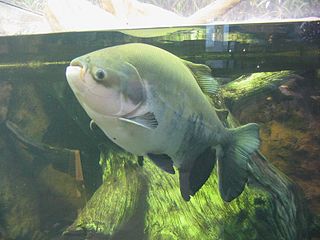
Pacu is a common name used to refer to several species of omnivorous South American freshwater serrasalmid fish that are related to the piranha. Pacu and piranha do not have similar teeth, the main difference being jaw alignment; piranha have pointed, razor-sharp teeth in a pronounced underbite, whereas pacu have squarer, straighter teeth and a less severe underbite, or a slight overbite. Pacu, unlike piranha, mainly feed on plant material and not flesh or scales. Additionally, the pacu can reach much larger sizes than piranha, at up to 1.08 m in total length and 40 kg (88 lb) in weight.

The Prochilodontidae, or flannel-mouthed characins, are a small family of freshwater fishes found primarily in the northern half of South America, south to Paraguay and northern Argentina. This family is closely related to the Curimatidae, and in the past they were included in Characidae.

The black myotis is a vesper bat species from South and Central America.

The tambaqui is a large species of freshwater fish in the family Serrasalmidae. It is native to tropical South America, but kept in aquaculture and introduced elsewhere. It is also known by the names black pacu, black-finned pacu, giant pacu, cachama, gamitana, and sometimes as pacu.

Salminus brasiliensis is a large, predatory characiform freshwater fish found in central and east-central South America. Despite having Salminus in its name, the dorado is not related to any species of salmon, nor to the saltwater fish also called dorado. It is very popular among recreational anglers and supports large commercial fisheries.
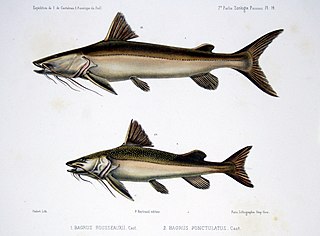
Brachyplatystoma is a genus of catfish from the family Pimelodidae. As the occasionally used common name goliath catfishes indicates, this genus includes some of the largest species of catfish, including the piraíba, B. filamentosum, which reaches up to the region of 3.6 metres (12 ft) in length. Brachyplatystoma are found in the Amazon and Orinoco basins, and other tropical freshwater and brackish habitats in South America. Some species are migratory. These fish are important as food fish and, to some extent, aquarium fish.
Hypophthalmus is a genus of long-whiskered catfishes native to freshwater in tropical and subtropical South America.
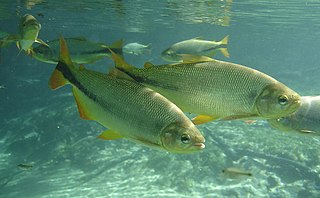
Brycon is a genus of fish in the family Characidae found in freshwater habitats in Central and South America, ranging from southern Mexico to northern Argentina. Despite not being closely related to true trout, they are sometimes called South American trout. Members of the genus may be referred to by a number of other different common names in various languages. They reach a maximum length of 11.9–79.5 cm (4.7–31.3 in) depending on the species involved. Some species perform seasonal breeding migrations.

Piaractus brachypomus, the pirapitinga, is a large species of pacu, a close relative of piranhas and silver dollars, in the serrasalmid family. It is native to the Amazon basin in tropical South America, but it formerly included populations in the Orinoco, which was described in 2019 as a separate species, P. orinoquensis. Additionally, P. brachypomus is widely farmed and has been introduced to other regions. In South Florida they are invasive in rivers, canals or lakes.
P. nigricans may refer to:

The biara is a South American piscivorous fish in the dogtooth characin family. It belongs to the monotypic genus Rhaphiodon, although some minor differences in morphometrics and colour are known from across its large range. It is found in the Amazon, Orinoco, and Río de la Plata Basins, as well as rivers of the Guianas. It occurs in a wide range of freshwater habitats such as main river channels, flooded forests, lakes and reservoirs. Some populations are migratory.

Prochilodus is a genus of freshwater fish from the family Prochilodontidae. This family include two other genera, Ichthyoelephas and Semaprochilodus, which have been included in Prochilodus instead. The greatest species richness of Prochilodus is in river basins in eastern, southeastern and southern Brazil, but there are also species in the river basins of the Amazon, Guianas, Colombia, Venezuela, Paraguay and northeastern Argentina. The largest species in the genus reach about 80 centimetres (2.6 ft) in length, but most species barely reach half that size.
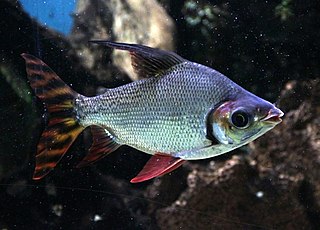
Semaprochilodus is a genus of South American freshwater fish in the family Prochilodontidae. They have sometimes been included in the genus Prochilodus instead. Of the six species, three are from the Amazon Basin, two from the Orinoco Basin and a single from the Maroni Basin. Depending on the exact species, they reach a maximum length of 27–54 centimetres (11–21 in).

Mylossoma is a genus of serrasalmids from tropical and subtropical South America, including the basins of the Amazon, Orinoco, Lake Maracaibo and Paraguay-Paraná. These common fish are found both in main river sections and floodplains. They support important fisheries and based on a review by IBAMA, they are the seventh most caught fish by weight in the Brazilian Amazon. They primarily feed on plant material such as seeds and fruits, and in their ecology they generally resemble the larger tambaqui. Mylossoma reach up to 28.5 cm (11.2 in) in length and 1 kg (2.2 lb) in weight.
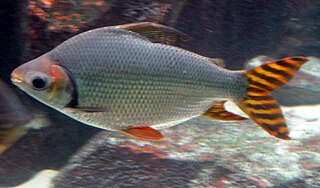
The kissing prochilodus or flag-tailed prochilodus is a species of South American freshwater fish in the family Prochilodontidae. It is native to central and western parts of the Amazon basin. It is migratory, moving in large groups into whitewater rivers to spawn, afterwards returning to blackwater and clearwater rivers, as well as flooded forests. It is important in fisheries and sometimes seen in the aquarium trade, but require a relatively large tank. It can reach a maximum standard length of 27.5 cm (10.8 in) and weight of 560 g (1.23 lb). It resembles the other members of the genus Semaprochilodus, where most species are silvery with orange-red fins and a striped tail. Adult S. insignis lack the dark flank spots that can be seen in adult S. taeniurus, but both species have these spots as juveniles.

A whitewater river is classified based on its chemistry, sediments and water colour. Whitewater rivers have high levels of suspended sediments, giving the water a pH that is near-neutral, a high electric conductivity and a pale muddy, coffee and cream-like colour. Whitewater rivers are of great ecological importance and are important to local fisheries. The major seasonal Amazonian floodplains known as várzea receive their water from them.

A clearwater river is classified based on its chemistry, sediments and water colour. Clearwater rivers have a low conductivity, relatively low levels of dissolved solids, typically have a neutral to slightly acidic pH and are very clear with a greenish colour. Clearwater rivers often have fast-flowing sections.
















